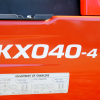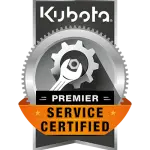Maintaining your tractor is the easiest investment of time and money you can spend to keep your tractor healthy and its life long. If you have a newer tractor, you want to read through the warranty because most tractor manufacturers will not cover repairs on a damaged or defective part if the owner has tampered with it. With that warning aside, there are still plenty of ways you can maintain your tractor and not void your warranty.
Modern tractors are technical, so you probably want to avoid any type of engine or transmission repair yourself. Let the dealer handle those jobs. What you can do is focus on general maintenance such as changing the oil and making sure that small issues are repaired quickly. One of the biggest keys to helping you with tractor maintenance will be the scheduled maintenance log found in the owner’s manual. It will outline what the manufacturer expects in terms of maintenance. Just like your vehicle, your tractor will require scheduled maintenance.
The big difference between vehicles and tractors is that you count tractor maintenance by the hour rather than by the mile.
Be Cautious: What You Can Do and What Your Dealer Should Do
Your tractor maintenance checklist should never involve:
- Engine – Most if not all engine work will need to be done by your dealer or approved mechanic. Not using an approved professional can void the warranty on your tractor.
- Electrical – Even brand-new electrical parts that have been opened and not touched are generally not something you can return. Do not work on the electrical systems of your tractor. Modern tractors have complex electrical systems, and their parts regulate engine and transmission performance and safety features. Leave the electrical work to a trained tractor mechanic.
- Power train (transmission) – Transmission work should always be completed by a professional. Modern tractors have a lot of features that are controlled by their computer and the problems that you encounter may not be a mechanical issue, but a computer or electronic issue. Without the proper equipment to test and diagnose you are poking around in the dark.
When your tractor is not working it is a big deal – time lost, projects delayed, and the clock is ticking away. However, you want to protect your tractor’s warranty. You can and should bring your tractor to the dealer or schedule mobile tractor service. If the issue is covered by a warranty, it should not cost you anything. However, if you void the warranty even once, the warranty is voided, and you will have to pay for all the issues the warranty covered moving forward.
Tractor Maintenance Checklist for Items You Can Maintain
- Oil Changes – These are pretty easy but keep in mind that the products you use must meet the demands of the warranty. That means using Kubota or New Holland products – filter and oil.
- Filter Changes-including oil and air filters and replace them with OEM or equivalent generally which means a Kubota or New Holland filter.
- Basic Maintenance and Pre-Work Service – If it is the mowing season you want to maintain your mower including sharpening the blades and making sure the moving parts are free of plant material, string, wire, etc. You can change or maintain the battery. Check the fuel filter, especially if the tractor has sat for a while. There are also hydraulic filters that you can change. For engine maintenance changing the spark plugs and oil is okay for gas engines and checking and replacing the fan belts or also okay.
Not only will general maintenance help extend the life of your tractor, but often it will make the chores you do seem easier. If you are not up to regular maintenance, you can bring the tractor to Nelson Tractor Company or use their mobile service.
Right to Repair
For many years, farmers and farming groups have been trying to get US tractor manufacturers to open up about the tech side of modern farm equipment. Without an understanding of how tech works or what it does, DIY and non-branded tractor mechanics have a difficult time accurately diagnosing and repairing issues with modern farm equipment. That process is changing, if slowly. Until it does, taking your tractor to an authorized dealer is your best option for protecting the warranty.
Tractor Maintenance Checklist
Be sure to check your manufacturers’ owner manual for a brand-specific maintenance checklist for your tractor.
| General Tractor Maintenance Plan | ||
| Maintenance Task | When to Do | Dealer Service Recommended |
| Fluid Levels | Before Starting Engine | |
| Tire Pressure | Before Starting Engine | |
| Air Filter | Every 10–15 hours | |
| Fuel Filter or Bowl | Every 10–15 hours | |
| Fittings – lube and grease | Every 10–15 hours or after heavy usage | |
| Engine Oil Change | Every 50 hours or yearly | |
| Belts, hoses, and lines | Every 100 hours or yearly | |
| Filter Replacement | Every 200–500 hours | |
| Transmission Fluid | Every 500 hours | Dealer Recommended Service |
| Coolant Flush | Every year in cold or hot climates | |
- Fluid Levels – Oil, Transmission, Fuel, Hydraulic, etc.
- Filter Replacement – Air filter and fuel filter – Hydraulic filters may be a dealer service item and not a DIY project. Air filters should be changed when they are visibly dirty or when you hit 200 hours of service. Fuel filters should be changed as needed, especially if your tractor sits for longer periods between usage.
- Coolant Replacement and System Flush – Follow the manufacturer’s guidelines. Some products may break down quickly under cold or hot climate conditions, even if the unit is just sitting.
Daily Maintenance – Before Use
Some chores need to be done before you use a tractor. Those include checking the tires for damage and air pressure, checking the oil, and checking the coolant levels. If your tractor has a cab, make sure the windows are clean and the inside is free of clutter.
Every 50 Hours
At the 50-hour mark, you should change the engine oil and filter. This will vary based on visual observation of the quality of the oil and the recommended oil change in your owner’s manual.
Inspect the batter and make sure that terminals are clean and free of corrosion. If equipped with a fluid reservoir check the batter cell level.
Every 100 Hours
Repeat the 50-hour maintenance and visually inspect the filters – fuel, air, etc. Replace as needed. If the hydraulic system is a closed system, it should be serviced by the dealer.
Belts, hoses, and lines need to be checked and replaced, especially if you live and work in cold or hot climates. Hydraulic lines should be replaced at the dealer. Also, be sure to use recommended replacement parts to protect your warranty.
Every 200 Hours
Replace all the filters – fuel, air, etc. If your tractor has a cab, make sure the window washing system is working. If your tractor has AC – be sure to test it. The dealer can check the coolant level and repair and top if needed.
Every 500 Hours
Transmission service and fluid replacement. This should be performed by your dealer. Visually inspect the radiator for signs of fin damage. Replace as needed. In addition, all the hourly maintenance milestones will flip over every 50, 100, and 200 hours.
Every 1000 Hours
Every 1000 hours of usage means a dealer service to check the valve clearance. It is a good time to have the dealer look over the tractor and make recommendations for other service needs.
Preventative maintenance is the best way to keep your tractor running strong and dependably regardless of the number of hours it has on the clock. The clock time refers to the engine run time. It pays to maintain and monitor all the systems on your tractor. The difference between great tractor maintenance and not is a tractor that lasts five years rather than 20 years. There are 40-year-old Kubota tractors still working thanks to great maintenance.









